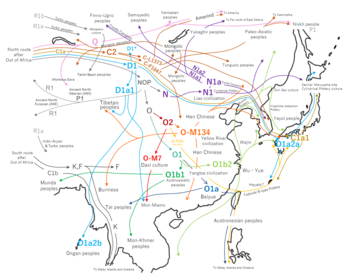| Haplogroup C-M8 (C1a1) | |
|---|---|
 Migration route of Haplogroup C | |
| Possible time of origin | 41,900YBP[1] 51,800YBP[2] |
| Coalescence age | 11,650YBP[3] |
| Possible place of origin | southeast Asia[4] |
| Ancestor | (Grandparent) Haplogroup C1a |
| Defining mutations | M8, M105, M131, P122 |
| Highest frequencies | Jōmon people, Japanese people |

Haplogroup C-M8 also known as Haplogroup C1a1 is a Y-chromosome haplogroup. It is one of two branches of Haplogroup C1a, one of the descendants of Haplogroup C-M130.
It has been found in about 6% (2.3% to 16.7%) of modern males sampled in Japan and has been considered to be a Y-DNA haplogroup descended from Jōmon people.[5][6] Elsewhere, it has been observed among academic studies only in one individual in a sample collected on Jeju Island of South Korea[7] and in commercial testing in one individual who has reported an origin in Liaoning province of China and one individual who has reported an origin in Seoul, South Korea.[8]
The MRCA with its sister haplogroup C-V20 dates back to 40,000[1] to 50,000[2] years ago. Diffusion of existing subtypes of C-M8 is estimated to have begun about 12,000 years ago.[3]
C1a1 is found in the Jōmon people and are linked to the Jomon people who came from the south route.
- ^ a b Zhong H, Shi H, Qi XB et al. (July 2010). "Global distribution of Y-chromosome haplogroup C-M130 reveals the prehistoric migration routes of African exodus and early settlement in East Asia". J. Hum. Genet. 55 (7): 428–35. doi:10.1038/jhg.2010.40. PMID 20448651.
- ^ a b G. David Poznik, Yali Xue, Fernando L. Mendez, et al., "Punctuated bursts in human male demography inferred from 1,244 worldwide Y-chromosome sequences." Nature Genetics 2016 June ; 48(6): 593–599. doi:10.1038/ng.3559.
- ^ a b Hammer MF, Karafet TM, Park H et al. (2006). "Dual origins of the Japanese: common ground for hunter-gatherer and farmer Y chromosomes". J. Hum. Genet. 51 (1): 47–58. doi:10.1007/s10038-005-0322-0. PMID 16328082.
- ^ "FamilyTreeDNA - Genetic Testing for Ancestry, Family History & Genealogy".
- ^ Michael F Hammer; Tatiana M Karafet; Hwayong Park; Keiichi Omoto; Shinji Harihara; Mark Stoneking; Satoshi Horai (2006). “Dual origins of the Japanese: common ground for hunter-gatherer and farmer Y chromosomes”. Journal of Human Genetics 51 (1): 47 - 58. doi:10.1007/s10038-005-0322-0. PMID 16328082.
- ^ Nakahori, Yutaka; Iwamoto, Teruaki; Yamauchi, Aiko; Ewis, Ashraf A.; Shinka, Toshikatsu; Sato, Youichi (2014). "Overview of genetic variation in the Y chromosome of modern Japanese males". Anthropological Science. 122 (3): 131–136. doi:10.1537/ase.140709. ISSN 0918-7960.
- ^ Kim, Soon-Hee; Kim, Ki-Cheol; Shin, Dong-Jik; Jin, Han-Jun; Kwak, Kyoung-Don; Han, Myun-Soo; Song, Joon-Myong; Kim, Won; Kim, Wook (2011). "High frequencies of Y-chromosome haplogroup O2b-SRY465 lineages in Korea: A genetic perspective on the peopling of Korea". Investigative Genetics. 2 (1): 10. doi:10.1186/2041-2223-2-10. PMC 3087676. PMID 21463511.
- ^ YFull Haplogroup YTree v6.02 at 02 April 2018